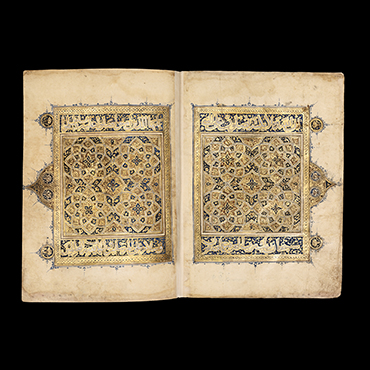Sheikh Nasser Sabah al-Ahmad al-Sabah discovered his love of art while studying in Jerusalem in the AH 1380s/1960s CE. Today, the collection he built with his wife, Sheikha Hussa Sabah al-Salim al-Sabah, includes more than 30,000 objects spanning 6,000 years of human creativity. The richness of these holdings reflects the variety that has shaped the arts of Islam, inspired by influences gathered along the trade routes linking China, Afghanistan, Central Asia, Persia, India, the Arabian Peninsula, and the Mediterranean basin.
In AH 1403/1983 CE, Sheikh Nasser decided to share the collection with the public, displaying it at the Kuwait National Museum. However the museum was later destroyed during the Iraqi invasion in AH 1410/1990 CE. Since then, parts of the collection have been exhibited at the Amricani Cultural Centre in Kuwait City and loaned to institutions around the world.
The Al-Sabah collection featured in the Homage section of AlMadar in the AH 1444/2023 CE Islamic Arts Biennale. For the AH 1446/2025 CE edition, the collection showcases objects with geometric designs. Geometry is the branch of mathematics that describes the properties of points, lines, surfaces, and solids. In art, design derived from geometry is characterized by motifs with regular lines and shapes such as triangles, pentagons, and octagons. The decorative motifs on this grouping of objects takes the star as the organizing principle. It is at the center of a variety of patterns that repeat as needed to cover the surface of objects, walls, carpets, and other items.
Illuminated finispiece of a Qur’an with a star-based pattern
This large, single-volume Mamluk Qur’an manuscript is written in thirteen lines of black muhaqqaq script, a favorite among calligraphers for large Qur’ans of this period. Gold whirling rosettes are positioned between each verse, with gold palmettes marking every fifth and tenth verse. An inscription at the bottom of folio 2v, continuing onto folios 3r and 4r, indicates the endowment of the Qur’an, stating: “Bequeathed by ordinance of God, Yusuf Agha to the ‘Abd al-Baqi Pasha mosque, in the town of Rushuq.” Additional writings, added at a later date on the front and back of the Qur’an, offer two different methods for interpreting dreams. The Qur’an also features intricate illumination on both the opening and closing pages. The design includes two rectangular geometric panels of overlapping circles that form a configuration of four eight-pointed stars with gold strapwork around the central panel. Headings, in white thuluth script located at the top and bottom of the finispiece (folios 303v–304r), contain Qur’anic inscriptions from chapter Al-Ahzab (33:57) and chapter Al-Saffat (37:180–182). The star motif used in the illumination is based on a pattern of stars and convex polygons, both of which derive their aesthetic appeal from the symmetrical arrangement of points around a circle.
Egypt, Probably mid-8th century AH/14th century CE with later binding, muhaqqaq and thuluth scripts
Ink, opaque watercolors, and gold on paper; dark-brown leather binding with stamped medallion, h. 35 × w. 27 cm
The Al-Sabah Collection, Dar al-Athar al-Islamiyyah, Kuwait, LNS 282 MS

